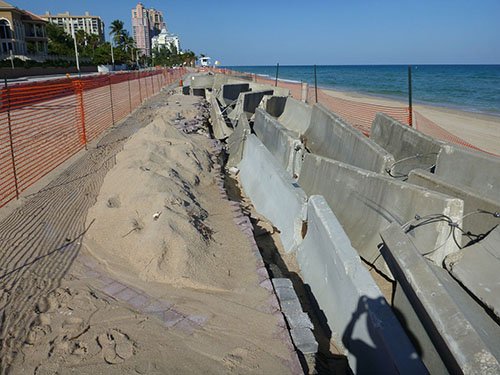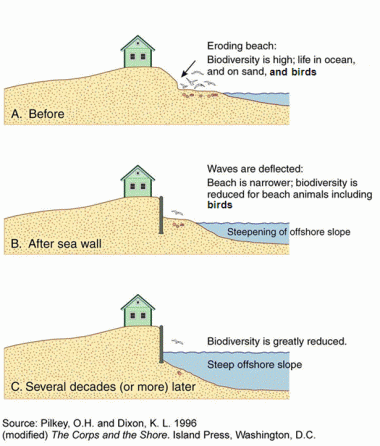Some Known Factual Statements About Shore Protect Team
Table of ContentsShore Protect Team Things To Know Before You Get ThisSome Known Details About Shore Protect Team The Best Guide To Shore Protect TeamThe smart Trick of Shore Protect Team That Nobody is DiscussingThe 5-Second Trick For Shore Protect TeamShore Protect Team - The Facts
Living shorelines make use of natural products such as plants, sand, rock, or oyster shells. Over time, living coastlines can come to be more stable as plants and origin systems grow and develop.They usually use marginal to no ecological benefits. Hard coastlines often tend to deteriorate with time due to wear and tear from waves and storms, and they can sustain higher upkeep costs if they require considerable fixings. Factors to consider for what methods to use to support a shoreline differ based upon details problems at the site, such as the amount of wave power, variant in low and high trends, and the incline of the shoreline.
What Does Shore Protect Team Do?


Planting indigenous greenery like dune yard is an effective method to shoreline erosion control. The rubbing avoids wind from openly surprising the sediments that comprise dunes. In locations where sand has actually currently been significantly eroded, sand replenishment is a practical method for restoration. Coral coral reefs protect shorelines by acting as a buffer for waves and stormy currents in addition to obstructing ship entrance.
The 4-Minute Rule for Shore Protect Team
They limit the transportation of coastline debris by recording the longshore current and are built to safeguard long stretches of land from disintegration. Debris that is cleaned down the shore is gathered on the updrift side of the structure. Breakwaters are structures developed parallel to the coast that "break" waves, decreasing the influence on the prone debris of the shoreline.
Made of rock and rubble, breakwaters are usually immersed undersea yet often can be seen from above. Generally made from tough materials like rock, timber, and concrete, they secure versus storm surges and are frequently made in emergencies since of their efficiency and fast building.
How Shore Protect Team can Save You Time, Stress, and Money.
Dunes are sand storage tanks that act as barriers versus wind and water to keep coastlines undamaged. Due to the fact that sand is such a light-weight compound, it is easily blown or flushed away by wind and water.
International climbing water level pose a threat to dune throughout the globe, however TrapBag can minimize erosion by reinforcing the dunes at their core and securing dunes from low-lying wind gusts. TrapBag can be utilized to produce seawalls and other coastline erosion protection structures. Shoreline disintegration control needs sturdy items that won't offer way despite hefty wind and rough waves, and TrapBag's high-strength fabric layout fits the costs.

The Shore Protect Team Ideas
Ensures compliance with Georgia's Coast Protection Act, managing activities near dunes and coastlines. Discover responses to common concerns regarding coastal permits, revocable licenses, and other vital information.
If you are planning any kind of building or activity in or near salt marsh in the State of Georgia, you need to contact our workplace for a jurisdictional determination and to discover if you require a CMPA authorization for your job. The Coast Defense Act (DAY SPA) controls activities and frameworks in administrative beach and shore locations.
Because 1982, the North Carolina Coastal Federation has worked to secure and bring back the coastal water top quality and habitats of North Carolina. We engage people from all profession, both homeowners and site visitors, that are committed to maintaining the North Carolina coast for current and future generations. Whether you live and work with the shore, browse through occasionally, or simply desire for walking along our stunning beaches, the health of your globe depends upon healthy oceans and coastal communities.
What Does Shore Protect Team Do?
We involve people from all profession, both locals and site visitors, to help us secure and bring back the shore for current and future generations. is the Federation's award-winning, daily, information service covering the environmental information of the North Carolina shore. Insurance coverage consists of science breakthroughs, government, and regulatory actions, and education and learning, in addition to the setting, culture, and history of the state's 20 coastal counties.
Editorial choices are made separately of the author and any various other individuals or rate of interests. Introduced in 2012, Coastal Review has been a participant of the North Carolina Press Association considering that 2015. In 2021, the press association identified Coastal Testimonial with a first-place award for civil service, together with a first-place award for look and layout and second-place honors for area coverage and basic quality.